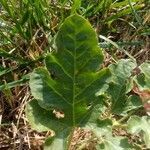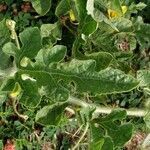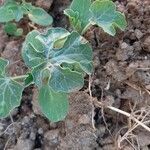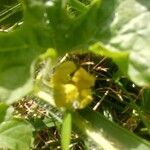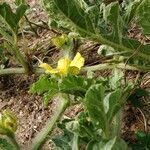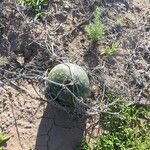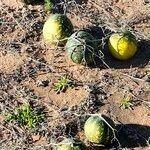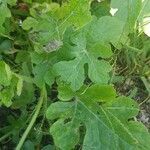Annual climber or trailer to 3 m.; stems herbaceous, rather softly long-hairy.. Leaf-blade ovate or elongated-ovate in outline, ± long-hairy on the nerves especially beneath, otherwise smooth, becoming scabrid-punctate especially beneath, membranous, 58–202 mm. long, 36–190 mm. broad, usually palmately deeply 3–5(–7)-lobed; lobes elongated-ovate in outline, ± pinnately sinuate-lobulate, rarely subentire, shallowly and obscurely sinuate-toothed, with the central lobe much the largest, obtuse to emarginate and apiculate; petiole long-hairy, 21–140 mm. long.. Tendrils bifid, rarely simple or (in extra-African forms) 3–4-fid.. Probract obovate-spathulate, hooded, 4–8 mm. long.. Male flowers on 12–40 mm. long pedicels; receptacle-tube pale green, 3–4 mm. long; lobes lanceolate, 3–5 mm. long; petals yellow, 7–16 mm. long and 5–10 mm. broad, united below.. Female flowers on 3–35 mm. long pedicels; ovary ellipsoid or subglobose, hairy, 6–12 mm. long, 5–8 mm. across; receptacle-tube 1.5–2 mm. long, lobes 3.5–4 mm. long; petals ± 11 mm. long and 5 mm. broad.. Fruit on a 20–40 mm. long stalk, ellipsoid or subspherical, 130–300 mm. or more in diameter, hairy, green mottled with paler green or yellowish in ± irregular longitudinal stripes or concolorous, terete or slightly ribbed, firm-walled, fleshy, indehiscent.. Seeds ovate in outline, ± 10 × 5 × 2.5 mm., sometimes smaller or more often rather larger, smooth or slightly verrucose, not or sometimes distinctly bordered.. Fig. 5/1–5, p. 45.
Annual herb, shoots to 3 m long, stem 2-4 mm diam., soft grey-hairy, hairs 2-3(-5) mm long. Probract narrowly elliptic, (sub)obtuse, narrowed at base, 5-15(-20) mm long, glands not obvious. Tendrils 2-or 3-branched. Leaves: petiole 3-12 cm long, soft hairy; blade pinnately (deeply) 3-5-lobed, ovate to narrowly elliptic in outline, 5-20 by 3-15 cm, glabrescent above, scabrid beneath, cystoliths and glands not obvious, base shallowly cordate, margin irregularly dentate, apex and apices of lobes rounded, obtuse or acute. Male flowers: pedicel 10-80 mm long, hairy; receptacle-tube 3-4 mm long, villous-hairy; sepals linear, 3-5 mm long; petals 8-15 mm long; filaments c. 2 mm long, glabrous, anthers connivent into a globose mass c. 3 mm diameter. Female flowers: pedicel 5-40 mm long; ovary 6-12 mm long, style 4-5 mm long. Fruit solitary, ripening (pale) green or greyish green without or with stripes or blotches, or yellow, (sub)globose or ellipsoid, 20-30(-60) cm long, glabrescent, smooth; exocarp hard but not woody; pulp (including mesocarp) white, yellow or pink(-red); fruiting pedicel 2-7 cm long. Seeds white, brown or nearly black, 6-12 mm long, smooth or ± rough, margin absent or present.
Annual, creeping, vines; stems lanate when young, later glabrescent. Leaves triangular ovate, 8-20 cm long, 5-15 cm wide, pinnatifid or bipinnatifid, the lobes broad, the sinuses rounded, the apex of the lobes rounded or acute, the base cordate, 3-veined, the margin undulate or irregularly toothed, pale green, charta-ceous, the upper surface sparsely lanate on the veins, glaucous, minutely pustu-late dotted, the lower surface somewhat lanate, especially on the veins; petioles villous or lanate, 3-8 cm long, striate; tendrils villous or lanate, 2-to 5-branched. Staminate flowers axillary, usually solitary, moderate in size; peduncles 2-4 cm long, villous or lanate; calyx broadly campanulate, ca. 1 cm long, green, villous, the lobes linear lanceolate, subequalling the tube; corolla campanulate, 2.5-3.0 cm long, the lobes ovate oblong, obtuse, yellow, the outer surface villous, the inner surface papillose, 5-nerved; filaments 2-3 mm long, stout, glabrate, slightly
An annual climber with deeply divided leaves and tendrils along the vine. It trails over the ground and has hairy, angular stems. The leaves are on long leaf stalks. The leaves are deeply divided along their length. These lobe are rounded and can themselves be divided. The leaves are 5-20 cm long by 2-12 cm across. The tendrils are divided. The plant has separate male and female flowers on the same plant. The flowers are pale yellow and smaller than pumpkins. The flowers occur in the axils of leaves. The male flowers appear first. Fruit are large and round or oval. They can be 60 cm long. Fruit have a hard smooth skin. Several fruit colours and shapes occur. Often they have a dark green mottle. The fruit has reddish juicy flesh and black or red seeds. The seeds are oval shaped and smooth. The seed size and shape vary considerably.
Monoecious, annual herb. Stems prostrate, scandent, up to 3 m long, ± hairy, glabrescent. Tendrils 2-or 3-fid. Leaves up to 200 x 190 mm, outline ovate to cordate, deeply palmately 3-5-lobed; lobes elliptic, ± pinnately lobulate, subentire, central largest, hairy to scabrid-punctate; petioles 20-185 mm long, hairy. Flowers yellow, solitary. Male flowers on hairy 12-45 mm long pedicels; receptacle tube 2.5-5.0 mm long, pale green; lobes 2.5-5.0 mm long, lanceolate; petals 7-19 mm long, obovate. Female flowers on 3-45 mm long pedicels; receptacle tube 1.5-2.0 mm long; lobes 2.5-5.5 mm long. Flowering time mainly Jan., Feb. Fruit 15-200 mm in diam., subglobose, ± green mottled darker green, stalk 20-50 mm long. Seeds ovate-elliptic, 9-11 mm long, ± smooth, dark or pale, often mottled.
Plants annual. Stem and branches robust, sulcate-angular, villous. Tendrils puberulent, 2-fid. Petiole 3-12 cm, densely pubescent; leaf blade white-green, triangulate-ovate, 8-20 × 5-15 cm, both surfaces hispid, 3-partite; segments lobulate, base cordate, sinus semicircular, apex acute or acuminate. Flowers solitary. Male flowers: pedicel 3-4 cm, villous; calyx tube densely villous; segments narrowly lanceolate, 2-3 mm; corolla pale yellow, 2.5-3 cm in diam.; segments ovate-oblong, 1-1.5 × 0.5-0.8 cm; stamens nearly free. Female flowers: calyx and corolla as in male flowers; ovary 5-8 mm, densely villous; stigmas 3, reniform. Fruit globose or oblong, smooth. Seeds numerous, color various, ovate, 1-1.5 × 0.5-0.8 cm. Fl. and fr. Apr-Oct.
Annual with long, procumbent, densely softly hairy stems. Petioles to c. 8 cm long, with dense, soft hairs. Lamina pinnatisect, often almost divided to midrib, to c. 15 × 13 cm, broad-ovate; lobes irregularly subdivided or toothed, hairy, blunt. Peduncles 1-3 cm long, densely hairy. Calyx lobed to 1/2 way or more, usually densely hairy; lobes narrow-lanceolate to linear. Corolla lobed nearly to base; lobes 12-16 × 8-12 mm, often unequal, ± elliptic, yellow with green raised veins, obtuse or mucronate. Ovary woolly at first, soon glabrate. Fr. subglobose to ± ellipsoid, becoming very large (to > 40 cm long in cultivation); rind green, hard; pulp red, sweet and very succulent. Seeds dark, shining.
Annual; stems villous to pilose. Tendrils 2–4-branched, rarely simple. Probract obovate to spathulate, 3–20 mm long. Leaves ovate, cordate at base; lamina 3–20 cm long, 3–15 cm wide, usually palmately 3–5-lobed; lobes ovate, sinuate-dentate to pinnately lobulate, emarginate to apiculate, glabrescent above, scabrid beneath; petiole 2–12 cm long, pilose. Male flowers on pedicels 12–80 mm long; hypanthium 3–4 mm long; calyx lobes 3–5 mm long; corolla lobes 5–16 mm long. Female flowers on pedicels 3–35 mm long; ovary 6–12 mm long. Fruit 6–15 cm diam., glabrescent, green with pale irregular stripes; pedicel 2–4 cm long. Seeds 9–12 mm long, smooth or slightly rough, brown with darker markings.
diverging, the anthers ca. 3 mm long; pistillodium glanduliform. Pistillate flow-ers similarly disposed as the staminate flowers; calyx and corolla as in the stami-nate; ovary ovoid, the style column slender, the stigmas short, the lobes spread-ing; staminodia setiform, villous at the base. Fruits green, mottled, or striped with dark and light green, globose to oblong, white within, the outer rind hard, the inner flesh pink or yellow, smooth, glabrous; seeds numerous, elliptical, 3-12 mm long, dirty white to black or mottled, smooth or nearly so.
Monoecious, hairy annual, with prostrate stems, up to 3 m long, with robust, usually bifid tendrils. Leaves ± ovate, up to 200 mm long, deeply trifid, with rounded, slightly toothed lobes. Male and female flowers solitary in leaf axils, up to 30 mm diam., greenish yellow. Fruit globose, 30-200 mm diam., glabrous, mottled green, flesh white, edible, (sometimes used for preserve, progenitor of watermelon).
Annual herb; monoecious. Stems procumbent or scandent. Tendrils 2-or 3-fid. Leaves petiolate; blade deeply palmately 3-5-lobed, lobes elliptic, shallowly to deeply pinnately lobulate, margin subentire or obscurely sinuate-denticulate; petioles up to 120 mm long. Flowers: male and female solitary; corolla yellow; Oct.-May. Fruit subglobose, 15-200 mm in diameter, greenish mottled with darker green.
Leaf-lamina 5–20 × 3·5–19 cm., ovate or narrowly ovate in outline, cordate, ± hairy (especially on the veins beneath), becoming scabrid-punctate, usually deeply palmately 3–5-lobed, the lobes elliptic in outline, shallowly to usually deeply ± pinnately lobulate, subentire or obscurely sinuate-denticulate, rounded to subacute, apiculate, the central much the largest.
Prostrate or scandent annual herb. Tendrils 2-or 3-fid. Leaf lamina deeply palmately 3-5-lobed; lobes elliptic in outline, shallowly to deeply pinnately lobulate, subentire or obscurely sinuate-denticulate. Male and female flowers solitary. Fruits 15-200 mm in diameter, subglobose, greenish mottled with darker green. Flowers yellow.
Fruit of wild plants 1·5–20 cm. in diameter, subglobose, greenish mottled with darker green, of cultivated plants up to 60 × 30 cm., subglobose or ellipsoid, green or yellowish, concolorous or variously mottled or striped; fruit-stalk 2–5 cm. long.
male flowers on ± villous 12–45 mm. long pedicels; receptacle-tube 2.5–5 mm. long, pale green, lobes 2·5–5 mm. long, lanceolate. Petals 0·7–1·9 × 0·4–1·4 cm., obovate, rounded, apiculate.
Female flowers on 3–45 mm. long pedicels; ovary 6–15 × 4–8 mm., ellipsoid or subglobose, villous; receptacle-tube 1·5–2 mm. long, lobes 2·5–5·5 mm. long; corolla as in male flowers.
Monoecious, hairy, trailing annual to 3 m long. Leaves pinnatisect with rounded, slightly toothed lobes. Flowers solitary in axils, greenish yellow. Fruits globose, mottled green.
Seeds c. 9–11 × 5–6 × 2·5–2·7 mm., ovate-elliptic in outline, smooth or slightly verrucose, dark or pale coloured, often mottled, sometimes bordered.
Petioles 2–18·5 cm. long, ± hairy or villous, sometimes scabrescent.
Stems prostrate or scandent to 10 m., ± villous, glabrescent.
Probracts 4–18 mm. long, obovate-spathulate.
Tendrils 2–3-fid.
Annual herb.
